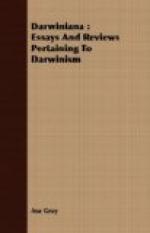the point here turns not upon absolute identity so
much as upon close resemblance. For those who,
with Agassiz, doubt the specific identity in any of
these cases, and those who say, with Pictet, that “the
later tertiary deposits contain in general the debris
of species very nearly related to those which still
exist, belonging to the same genera, but specifically
different,” may also agree with Pictet, that
the nearly-related species of successive faunas must
or may have had “a material connection.”
But the only material connection that we have an idea
of in such a case is a genealogical one. And the
supposition of a genealogical connection is surely
not unnatural in such cases—is demonstrably
the natural one as respects all those tertiary species
which experienced naturalists have pronounced to be
identical with existing ones, but which others now
deem distinct For to identify the two is the same
thing as to conclude the one to be the ancestor of
the other No doubt there are differences between the
tertiary and the present individuals, differences
equally noticed by both classes of naturalists, but
differently estimated By the one these are deemed
quite compatible, by the other incompatible, with
community of origin But who can tell us what amount
of difference is compatible with community of origin?
This is the very question at issue, and one to be
settled by observation alone Who would have thought
that the peach and the nectarine came from one stock?
But, this being proved is it now very improbable that
both were derived from the almond, or from some common
amygdaline progenitor? Who would have thought
that the cabbage, cauliflower, broccoli kale, and kohlrabi
are derivatives of one species, and rape or colza,
turnip, and probably ruta-baga, of another species?
And who that is convinced of this can long undoubtingly
hold the original distinctness of turnips from cabbages
as an article of faith? On scientific grounds
may not a primordial cabbage or rape be assumed as
the ancestor of all the cabbage races, on much the
same ground that we assume a common ancestry for the
diversified human races? If all Our breeds of
cattle came from one stock why not this stock from
the auroch, which has had all the time between the
diluvial and the historic periods in which to set
off a variation perhaps no greater than the difference
between some sorts of domestic cattle?
That considerable differences are often discernible between tertiary individuals and their supposed descendants of the present day affords no argument against Darwin’s theory, as has been rashly thought, but is decidedly in its favor. If the identification were so perfect that no more differences were observable between the tertiary and the recent shells than between various individuals of either, then Darwin’s opponents, who argue the immutability of species from the ibises and cats preserved by the ancient Egyptians being just like those of the present day, could triumphantly add a few hundred thousand years more to the length of the experiment and to the force of their argument.




